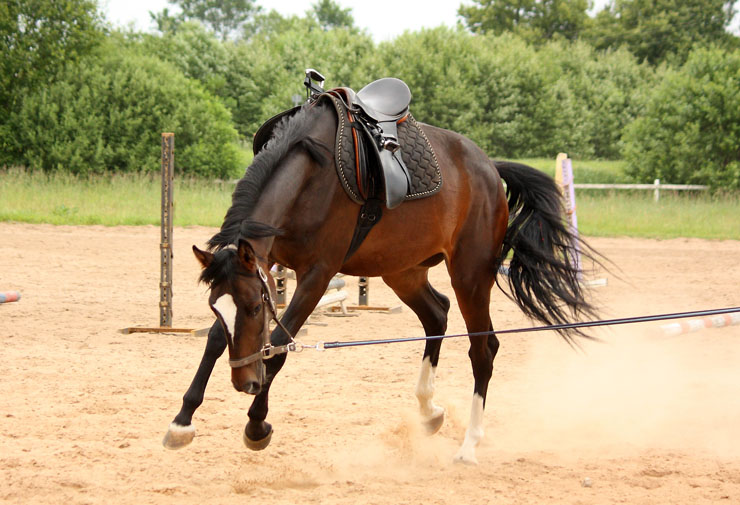10 Must Have’s For Training Young Horses

 Every trainer has a few favorite tools they rely on to get the job done. Even though different situations require different approaches, there are a few things I never leave home without.
Every trainer has a few favorite tools they rely on to get the job done. Even though different situations require different approaches, there are a few things I never leave home without.
1. Handy dandy loose ring snaffle on a leather western headstall: This is by far my favorite “baseline” bridle. From here you can build up to anything. It’s great as a first bit for a youngster and the slightly worn leather of the headstall makes it very comfortable. Clip on split reins help too and are very handy if you decide to do some extra lunging or long lining. TIP: When working a youngster, do not use tack you’re particularly attached to. When it comes to it, if something happens, I’d rather the headstall break than the horse.
2. Running Martingale: It’s there if you need it, but out of the way when you don’t. If you’re on a youngster that wants to run and doesn’t know better, that little bit of leverage will be your best friend. Otherwise, its out of the way and won’t become a distraction
3. Sturdy saddle: It seems simple, but when I’m getting on a young horse for the first time, I want to be in a saddle I’m comfortable in (right size, no worn leather, stirrups at a good length) and that fits the horse. TIP: Lunge in a saddle. If your saddle doesn’t fit perfectly, you’ll be able to see and make it more comfortable for them.
4. Polo wraps: A million and one uses, just like Duct Tape! Sure, they’re great protection for your horse’s legs, but how about as “baby’s first cinch”? Put the wrap over your horse’s back and pull it underneath their belly and pull snug. Viola! First cinch without a saddle. TIP: Be careful that you don’t tie the wrap and leave it. Those things are slippery and the last thing you want is that around a flank!
5. Navajo pad: It’s a light weight way to put something on your horse’s back that won’t injure them if it falls. Also, a great tool for desensitization (put it on the ground and walk over it).
6. Rope halter: Rope halters are great because they fit almost anything. With a little practice, you can get them on and off in no time. A good rope halter with knots on the nose band can help with a pushy horse TIP: Do NOT leave a rope halter on a horse. They can easily get caught on a fence and if not tied properly, can strangle your horse.
7. Lunge lines: Lunging is always a great way to start a training session. Let your nervous horse blow off a little steam. Long lining is beneficial too for more reasons than I can fit here.
8. Cowboy hat: Seems a little strange, but it works for me. When I’m working an abused horse in the round pen, the last thing I want to grab is a lunge whip. Hold out a cowboy hat for basically the same effect. Useful for loading as well.
9. Individually wrapped peppermints: “You catch more flies with honey than with vinegar.” Well, a peppermint is a great way to treat your horse. Individually wrapped mints fit in your pocket too! TIP: Don’t go too crazy with this. It’s a nice reward, but don’t make a mouthy horse. Also makes a nice reward for a trainer.
10. A healthy sense of humor: Probably the most important thing here. Horses, especially young or frightened horses, do silly or sometimes scary things. The best thing to do is smile, help your horse relax, and learn from the mistake. Training is tough for all involved but don’t take yourself too seriously!
Written By Sarah Kibbler. Share this on Facebook if a few of these things live in your tack trunk!





